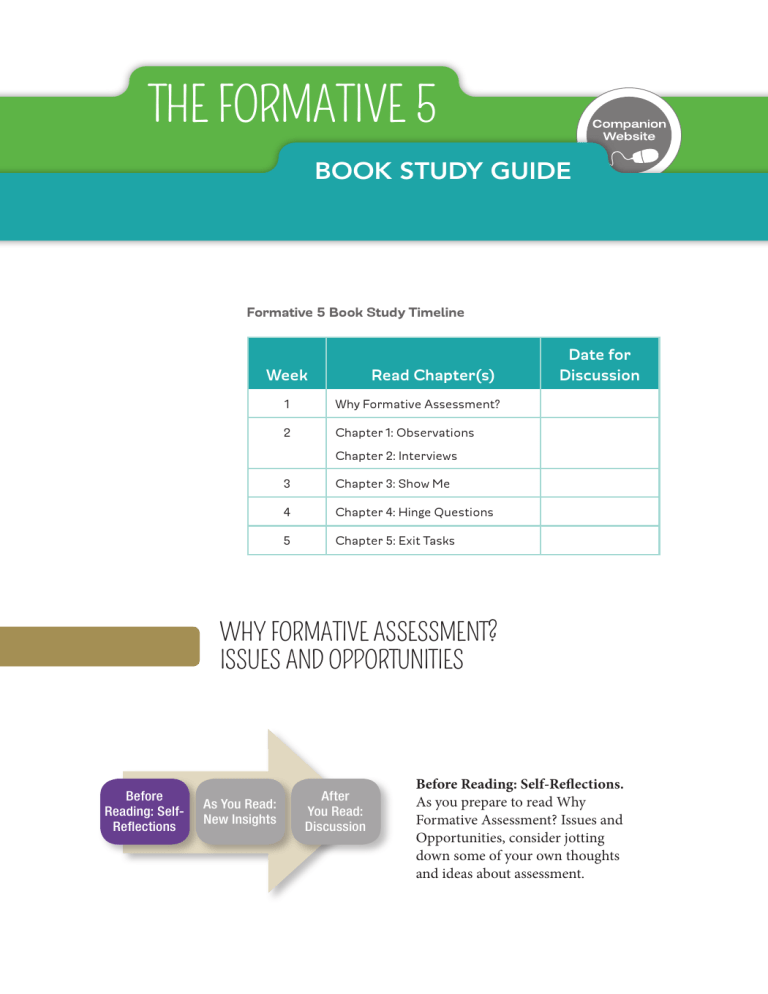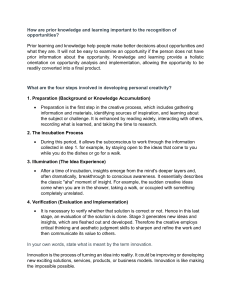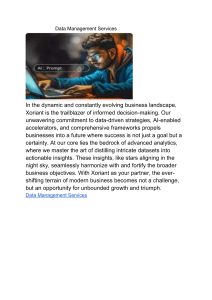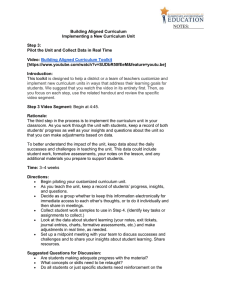
THE FORMATIVE 5 BOOK STUDY GUIDE Formative 5 Book Study Timeline Week Read Chapter(s) 1 Why Formative Assessment? 2 Chapter 1: Observations Date for Discussion Chapter 2: Interviews 3 Chapter 3: Show Me 4 Chapter 4: Hinge Questions 5 Chapter 5: Exit Tasks WHY FORMATIVE ASSESSMENT? ISSUES AND OPPORTUNITIES Before Reading: SelfReflections As You Read: New Insights After You Read: Discussion Before Reading: Self-Reflections. As you prepare to read Why Formative Assessment? Issues and Opportunities, consider jotting down some of your own thoughts and ideas about assessment. Prereading Questions 1. How does (or perhaps should) the use of formative assessment influence your instructional planning? 2. How much time do you spend each day as you assess student progress in mathematics? 3. How much time do you spend each month and during the entire school year assessing your students? Make sure to include the summative assessments you administer as well as the formative assessments you may provide. 4. In your own words, describe the differences between formative and summative assessments. 5. What formative assessment techniques are you currently using? 6. What concerns you the most about your use of formative assessment every day? 7. What concerns you the most about the imbalance, particularly as emphasized in reporting to parents and in the media, between formative and summative assessment? 8. How do you provide feedback to your students with regard to assessments that you use? Share this response with your building-based colleagues. 9. Is there a difference between how feedback is provided that is based on the developmental level of students? Does the mathematics content being assessed impact how you provide feedback? My Thoughts and Questions Before Reading: SelfReflections As You Read: New Insights After You Read: Discussion As You Read: New Insights. When working with a collaborative team, it is often very helpful to be prepared with notes about the reading. Use the following chart to record your notes. Thoughts on Why Formative Assessment? Issues and Opportunities Reading Notes Page I wonder . . . This connects to . . . I’d like to try . . . I am worried about . . . Before Reading: SelfReflections As You Read: New Insights Sharing After You Read: Discussion After You Read: Discussion. The chapter Why Formative Assessment? Issues and Opportunities introduces formative assessment beginning with a discussion of assessment literacy. After reading this section, begin your group session by sharing some of your thoughts about the reading. You may begin by revisiting the discussion questions introduced in the Before Reading section. You may use the following graphic organizer to record your ideas from the group discussion regarding sharing, identifying particular Aha! moments from the group, and then determining the next steps (Let’s Try!) for individuals or the group. As the group shares, each participant can record interesting thoughts, summaries, or new questions developed from the reading. The Aha! section is a place to record new insights, and Let’s Try! is the actionable item that the group will want to try after reading and discussing the chapter. Aha! Let’s Try! CHAPTER 1: Before Reading: SelfReflections OBSERVATIONS As You Read: New Insights After You Read: Discussion Prereading Questions 1. How often do you actually use observation? Would you consider your use of observation as formative assessment? 2. How might you use observation every day to monitor your students as you teach and as they learn mathematics? 3. In thinking about what you expect to observe, also think about how you would know “it” (what you expect) when you saw it. What will you do if you don’t see “it,” or students don’t do what you expect? 4. When would you actually make notes about what you have observed in your mathematics classroom? 5. Which of the observation tools in this chapter might you use or adapt and use in your own classroom? What observation tools have you created or used? Before Reading: Self-Reflections. As you prepare to read Chapter 1: Observations, take a minute to jot down some of your own thoughts and ideas about the questions below. Then revisit them as you share and discuss. My Thoughts and Questions Before Reading: SelfReflections As You Read: New Insights After You Read: Discussion As You Read: New Insights. Use the following chart to record your notes about Chapter 1: Observations. Thoughts on Chapter 1: Observations Reading Notes Page I wonder . . . This connects to . . . I’d like to try . . . I am worried about . . . Before Reading: SelfReflections As You Read: New Insights Sharing After You Read: Discussion Aha! After You Read: Discussion. Now that you have read Chapter 1: Observations and considered the Professional Learning Discussion Questions, you may revisit them as a guide to organizing your discussion. We suggest that you record relevant ideas from the group discussion in the graphic organizer below. Make sure to identify particular Aha! moments, and then some actionable items for individual participants or groups to actually try (Let’s Try)! Let’s Try! CHAPTER 2: Before Reading: SelfReflections INTERVIEWS As You Read: New Insights After You Read: Discussion Prereading Questions 1. Have you used interviews in your classroom? If so, how has their use impacted your planning and teaching? 2. What challenges do you envision as you think about daily use of the interview technique? 3. Which of the interview tools provided in this chapter would you use or adapt and use in your classroom? 4. How would you describe the link between your use of observation of mathematics teaching and the use of interviews in your classroom? 5. Think about one particular student you have and a recent or forthcoming lesson. How would that student would respond to the following interview questions? How did you do that? Tell me why you did “that” (e.g., solved that problem) that way. Before Reading: Self-Reflections. As you prepare to read Chapter 2: Interviews, make a note of some of your own thoughts and ideas about conducting interviews. My Thoughts and Questions Before Reading: SelfReflections As You Read: New Insights After You Read: Discussion As You Read: New Insights. Use the following chart to record your notes about Chapter 2: Interviews. Thoughts on Chapter 2: Interviews Reading Notes Page I wonder . . . This connects to . . . I’d like to try . . . I am worried about . . . Before Reading: SelfReflections As You Read: New Insights Sharing After You Read: Discussion After You Read: Discussion. Chapter 2 introduces interviewing as a formative assessment technique. After reading the chapter, begin your group session by sharing some of your thoughts about the reading. As with the previous chapters, you may begin by revisiting the discussion questions introduced in the Before Reading section. Use the graphic organizer below to record your ideas from the group discussion, identify particular Aha! moments from the group, and then determine the next steps (Let’s Try!) for individuals or the group. As the group shares, participants can record interesting thoughts, summaries, or new questions developed from the reading. The Aha! section is a place to record new insights and the Let’s Try! is the actionable item that the group will want to try after reading and discussing the chapter. Aha! Let’s Try! CHAPTER 3: Before Reading: SelfReflections SHOW ME As You Read: New Insights After You Read: Discussion Prereading Questions 1. How do you envision using a Show Me assessment in your classroom? 2. What challenges do you envision as you consider daily use of the Show Me technique? 3. Which of the Show Me examples provided in this chapter would you use or adapt for use in your classroom? 4. Are there particular lessons that you think would more likely engage many more Show Me opportunities than other lessons? Which? Why do you think so? 5. How would you describe the connection between observing, interviewing, and use of Show Me? How might this connection impact both your planning and teaching? 6. In your grade-level team, consider the major mathematics topics at your particular grade level. Spend time creating at least one Show Me prompt for each of these topics, making sure to find the time to share and discuss the prompts. Before Reading: Self-Reflections. As you prepare to read Chapter 3: Show Me, jot down some of your own thoughts and ideas about the questions below. Then make sure to revisit them as you share and discuss. My Thoughts and Questions Before Reading: SelfReflections As You Read: New Insights After You Read: Discussion As You Read: New Insights. Use the chart below to record your notes about your reading of Chapter 3: Show Me. Thoughts on Chapter 3: Show Me Reading Notes Page I wonder . . . This connects to . . . I’d like to try . . . I am worried about . . . Before Reading: SelfReflections As You Read: New Insights Sharing After You Read: Discussion. Chapter 3 introduces the Show Me formative assessment technique as a way to quickly assess student performance. After reading the chapter, begin your group session by sharing some of your thoughts about the reading. As with previous chapter discussions, begin by revisiting the discussion questions introduced in the Before Reading section. Use the graphic organizer below to record your ideas from the group discussion, identify particular Aha! moments from the group, and then determine the next steps (Let’s Try!) for individuals or the group. As the group shares, each participant can record interesting thoughts, summaries, or new questions developed from the reading. As noted previously, the Aha! section is a place to record new insights, and the Let’s Try! is the actionable item that the group will want to try after reading and discussing the chapter. After You Read: Discussion Aha! Let’s Try! CHAPTER 4: Before Reading: SelfReflections HINGE QUESTIONS As You Read: New Insights After You Read: Discussion Prereading Questions 1. How will you consider creating hinge questions as you plan your mathematics lessons? 2. What every-student-response techniques or materials might your students use as they respond to hinge questions? 3. Are there particular content topics that may be more appropriate for the multiple-choice format of the hinge question than others? 4. How can you use observations, interviews, and the Show Me technique to assist in your use of the hinge question? 5. How might your learning community plan for and develop hinge questions? 6. How might your learning community share, discuss, and reflect on student responses to hinge questions? How might it adapt them for future use? 7. The hinge question is considered to be diagnostic, as discussed in the chapter. How does the hinge question differ from other questions you may ask of your students? 8. How might you plan for a range of hinge questions that might be used across grade-level teams? Before Reading: Self-Reflections. As you prepare to read Chapter 4: Hinge Questions, jot down some of your own thoughts and ideas about the questions below. Revisit them as you share and discuss the chapter. My Thoughts and Questions Before Reading: SelfReflections As You Read: New Insights After You Read: Discussion As You Read: New Insights. Use the chart below to record your notes from the chapter. Thoughts on Chapter 4: Hinge Questions Reading Notes Page I wonder . . . This connects to . . . I’d like to try . . . I am worried about . . . Before Reading: SelfReflections As You Read: New Insights Sharing After You Read: Discussion After You Read: Discussion. Chapter 4 introduces the hinge question formative assessment technique as a critical question that helps you both assess student progress within a lesson and make instructional decisions. After reading this chapter, begin your group session by sharing some of your thoughts about the reading. You may begin by revisiting the discussion questions introduced in the Before Reading section. As with previous chapters, use the following graphic organizer to record your ideas from the group discussion, identify particular Aha! moments from the group, and determine the next steps (Let’s Try!) for individuals or the group. As the group shares, each participant can record interesting thoughts, summaries, or new questions developed from the reading. The Aha! section is a place to record new insights, and the Let’s Try! is the actionable item that the group will want to try after reading and discussing the chapter. Aha! Let’s Try! CHAPTER 5: Before Reading: SelfReflections EXIT TASKS As You Read: New Insights After You Read: Discussion Prereading Questions 1. How frequently would you use exit tasks? 2. How will you provide feedback to your students with regard to their exit task performance? 3. How will you consider the levels of cognitive demand as you select, adapt, or create tasks? 4. When might you use the exit task prior to the end of a lesson that you have taught or are teaching? 5. How might you consider exit tasks as ongoing preassessments for summative tests you might use, like unit tests? 6. What print or online sources do you particularly like when selecting mathematics tasks? 7. How will use of the exit task influence your planning and teaching? 8. How does the exit task connect with observations, interviews, Show Me, and the hinge question? 9. How will you share student work from exit tasks you will implement or have implemented? 10. What’s unique, compared to the other Formative 5 techniques, about the exit task? Before Reading: Self-Reflections. As you prepare to read Chapter 5: Exit Tasks, jot down some of your own thoughts and ideas about the questions below. Revisit them as you share and discuss. My Thoughts and Questions Before Reading: SelfReflections As You Read: New Insights After You Read: Discussion As You Read: New Insights. Use the following chart to record your notes. Thoughts on Chapter 5: Exit Tasks Reading Notes Page I wonder . . . This connects to . . . I’d like to try . . . I am worried about . . . Before Reading: SelfReflections As You Read: New Insights Sharing After You Read: Discussion After You Read: Discussion. Chapter 5 introduces the exit task formative assessment technique as a performance-based task that occurs near the conclusion of a lesson or perhaps a major concept or topic within a lesson. After reading this chapter, begin your group session by sharing some of your thoughts about the reading. You may begin by revisiting the discussion questions introduced in the Before Reading section. Use the following graphic organizer to record your ideas from the group discussion, identifying particular Aha! moments from the group, and then determining next steps (Let’s Try!) for individuals or the group. As the group shares, participants can record interesting thoughts, summaries, or new questions developed from the reading. As with the other chapter reviews, note that the Aha! section is a place to record new insights and the Let’s Try! is the actionable item that the group will want to try after reading and discussing the chapter. Aha! Let’s Try! Retrieved from the companion website for The Formative 5: Everyday Assessment Techniques for Every Math Classroom by Francis (Skip) Fennell, Beth McCord Kobett, and Jonathan A. Wray. Thousand Oaks, CA: Corwin, www.corwin.com. Copyright © 2017 by Corwin. All rights reserved. Reproduction authorized only for the local school site or nonprofit organization that has purchased this book.



